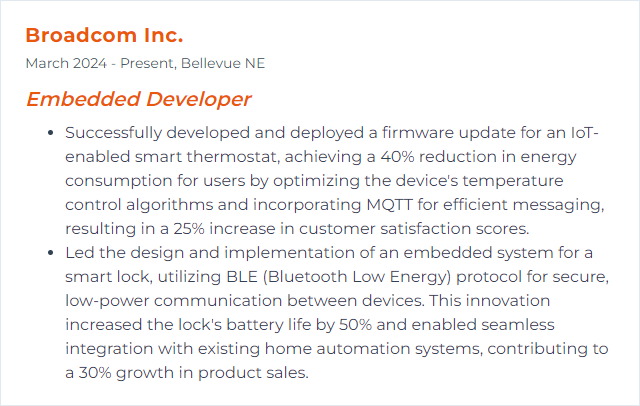Top 12 Embedded Developer Skills to Put on Your Resume
In today's rapidly evolving tech landscape, mastering the right mix of skills is crucial for embedded developers aiming to stand out in the job market. This article distills the top 12 competencies that embedded developers should feature on their resumes, ensuring they capture the attention of potential employers and secure their place at the forefront of technological innovation.
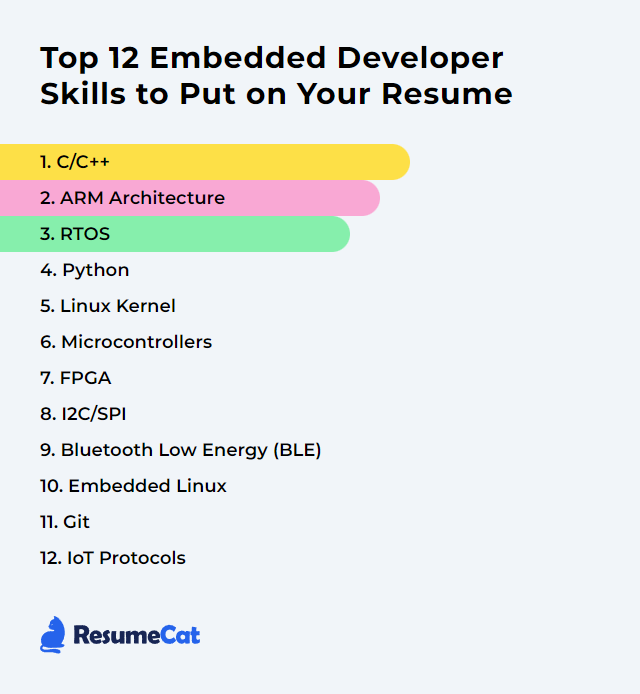
Embedded Developer Skills
- C/C++
- ARM Architecture
- RTOS
- Python
- Linux Kernel
- Microcontrollers
- FPGA
- I2C/SPI
- Bluetooth Low Energy (BLE)
- Embedded Linux
- Git
- IoT Protocols
1. C/C++
C/C++ for an embedded developer refers to two closely related programming languages commonly used for developing firmware and low-level software that directly interacts with hardware components in embedded systems, offering fine control over system resources and performance.
Why It's Important
C/C++ is crucial for embedded developers because it provides low-level access to hardware, enables precise control over system resources, and ensures efficient performance on constrained devices.
How to Improve C/C++ Skills
Improving your C/C++ skills, especially as an Embedded Developer, involves a combination of theoretical knowledge, practical experience, and understanding of the hardware-software interface. Here are concise steps with resources:
Master the Basics: Solidify your understanding of C/C++ fundamentals, including pointers, memory management, data structures, and algorithms.
Understand Embedded Systems Concepts: Learn about microcontrollers, peripherals, and interfacing techniques specific to embedded systems.
- Making Embedded Systems
Practice with Projects: Apply your knowledge through small to medium-sized projects, focusing on interfacing sensors, communication protocols (SPI, I2C, UART), and low-power optimization.
- Arduino Projects
- Raspberry Pi Projects
Learn Best Practices: Understand the coding standards and best practices for embedded C/C++, including MISRA C guidelines.
Optimization Techniques: Gain skills in optimizing code for performance and memory usage, critical in resource-constrained embedded systems.
- Embedded Artistry's Performance Optimization
Real-Time Operating Systems (RTOS): Learn about real-time concepts and how to use RTOS in your embedded applications.
Version Control and Documentation: Use version control systems like Git efficiently and maintain clear documentation for your code.
Join a Community: Engage with communities and forums for ongoing learning and support.
Continuous Learning: Stay updated with the latest trends in embedded systems, such as IoT, edge computing, and machine learning on microcontrollers.
Toolchains and Debugging: Get comfortable with cross-compilation toolchains and debugging techniques (gdb, JTAG, oscilloscopes).
By following these steps and utilizing the resources provided, you'll continue to improve your C/C++ skills in the context of embedded systems development.
How to Display C/C++ Skills on Your Resume

2. ARM Architecture
ARM architecture is a family of RISC (Reduced Instruction Set Computing) architectures for computer processors that emphasizes efficiency and low power consumption, widely used in embedded systems and mobile devices.
Why It's Important
ARM architecture is crucial for an embedded developer because it offers a high-performance, energy-efficient solution ideal for the power-constrained environments typical in embedded systems, enabling longer battery life and compact designs.
How to Improve ARM Architecture Skills
Improving ARM architecture from an embedded developer's perspective involves optimizing performance, power efficiency, and code efficiency. Focus on the following strategies:
Understand ARM Architecture: Start with a solid understanding of the ARM architecture you're working with. ARM provides comprehensive documentation which is crucial for optimization.
Efficient Coding: Write efficient, optimized code by leveraging ARM’s Compiler Hints and Tips. Use the ARM instruction set effectively to reduce code size and improve execution speed.
Power Optimization: Utilize ARM’s Power Management techniques to reduce energy consumption without sacrificing performance.
Use of NEON for SIMD: For applications requiring high performance in multimedia and signal processing, make use of ARM's NEON technology for SIMD (Single Instruction, Multiple Data) operations. ARM provides a guide to NEON programming.
Real-Time System Optimization: If working on real-time systems, optimize the Real-Time Operating System (RTOS) and consider using ARM's Cortex-R series for enhanced real-time performance.
Debugging and Profiling: Regularly use ARM's debugging and profiling tools, like DS-5 Development Studio, to identify bottlenecks and optimize code and hardware configuration.
Stay Updated: ARM architecture and tools are continually evolving. Stay updated with the latest developments through ARM's official blog and training courses.
Community and Forums: Engage with the ARM developer community. Forums like the ARM Community can provide valuable insights and solutions to specific challenges.
By focusing on these areas, embedded developers can significantly improve the performance and efficiency of systems based on ARM architecture.
How to Display ARM Architecture Skills on Your Resume
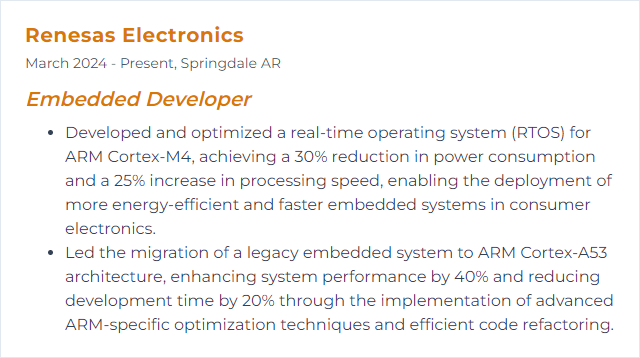
3. RTOS
RTOS (Real-Time Operating System) is a specialized operating system designed for managing hardware resources and executing tasks within strict timing constraints, essential for embedded systems requiring deterministic response times.
Why It's Important
RTOS (Real-Time Operating System) is crucial for embedded developers because it ensures timely and predictable task execution, essential for managing hardware resources efficiently and meeting the real-time constraints of embedded applications.
How to Improve RTOS Skills
Improving a Real-Time Operating System (RTOS) involves optimizing performance, ensuring reliability, and reducing power consumption. Here are concise steps an embedded developer can take:
Optimize Task Management: Prioritize tasks efficiently and use appropriate scheduling algorithms to improve the responsiveness of your RTOS. FreeRTOS Scheduling provides insights into task prioritization and scheduling.
Efficient Memory Management: Optimize memory usage by employing dynamic memory allocation carefully and considering stack sizes for tasks. Memory Management for Embedded Systems offers guidelines on managing memory efficiently.
Reduce Latency: Minimize system call latency and interrupt service routines (ISRs) duration. Techniques for reducing latency can be found in Optimizing the Real-Time Properties of an RTOS.
Power Consumption: Implement power management techniques, such as idle task hook to enter low power modes when possible. Power Management in Embedded Systems discusses strategies for reducing power consumption.
Use RTOS Analysis Tools: Utilize tools for tracing and profiling to identify bottlenecks and inefficiencies. Percepio Tracealyzer offers visualization of RTOS runtime behavior.
RTOS Configuration: Fine-tune RTOS configurations (e.g., tick rate, stack sizes) to balance between precision and resource usage. The Micrium Configuration Guide provides insights into configuring RTOS parameters.
Update RTOS Version: Stay updated with the latest RTOS version to leverage performance improvements and security patches. Check your RTOS provider’s website regularly for updates.
Security Measures: Implement security features to protect against vulnerabilities, including using secure boot and encryption for data protection. Securing Embedded Systems offers strategies for enhancing security.
By focusing on these areas, an embedded developer can significantly improve the performance and reliability of an RTOS.
How to Display RTOS Skills on Your Resume

4. Python
Python is a high-level, interpreted programming language known for its simplicity, readability, and versatility, widely used for scripting, automation, data analysis, and web development, including in embedded systems for rapid prototyping and developing applications with graphical interfaces or network communications.
Why It's Important
Python is important for an Embedded Developer due to its simplicity and efficiency in scripting, testing, and automating tasks, alongside its extensive libraries for IoT, data handling, and interfacing with hardware, enhancing productivity and reducing development time.
How to Improve Python Skills
To enhance your Python skills as an Embedded Developer, focus on mastering specific areas relevant to embedded systems. Here are concise recommendations with resources:
Understand Python for Embedded Systems: Grasp how Python can be used in embedded development, including interfacing with hardware. Python for Microcontrollers through MicroPython is a good starting point.
Learn Efficient Python Coding: Write efficient and optimized Python code, crucial for resource-constrained embedded systems. Python Speed offers guidelines on profiling and optimizing Python code.
Explore Python Libraries for Embedded Development: Familiarize yourself with libraries like PySerial for serial communication and RPi.GPIO for Raspberry Pi GPIO control. PySerial Documentation and RPi.GPIO provide comprehensive guides.
Practice with Real Hardware: Apply your skills on actual hardware. Start with Raspberry Pi or Arduino with a Python interface. Getting Started with Raspberry Pi and Arduino with Python can guide you through the process.
Stay Updated and Involved in the Community: Embedded systems and Python evolve rapidly. Participate in forums like Stack Overflow and Reddit’s r/Python to stay informed and get help.
By focusing on these areas and utilizing the provided resources, you can significantly improve your Python skills in an embedded development context.
How to Display Python Skills on Your Resume

5. Linux Kernel
The Linux Kernel is the core system software providing fundamental operations and interfaces for embedded devices, managing hardware resources, and enabling the execution of applications and processes.
Why It's Important
The Linux Kernel is crucial for an embedded developer as it provides a flexible, open-source, and highly configurable operating system foundation, enabling efficient hardware interaction, resource management, and support for a wide range of devices and architectures crucial in embedded systems development.
How to Improve Linux Kernel Skills
Improving the Linux Kernel, especially for an embedded developer, involves understanding kernel internals, contributing to its development, and optimizing for specific hardware. Here are concise steps and resources:
Learn Kernel Internals: Understanding how the kernel works is crucial. Start with foundational books and documentation.
Set Up a Development Environment: Ensure you have a robust environment for kernel development, including cross-compilation tools for embedded targets.
Optimize for Your Hardware: Tailor the kernel configuration for the specific embedded system you're working on.
- Use
make menuconfigormake xconfigto fine-tune kernel features. - Kernel Size Tuning Guide
- Use
Contribute to the Kernel: Start contributing patches for bugs or enhancements relevant to embedded systems.
- How to Contribute to the Linux Kernel
- Linux Kernel Mailing List
Stay Informed and Collaborate: Follow kernel updates, subscribe to mailing lists, and collaborate with the community.
Benchmark and Profile: Use tools to benchmark and profile kernel performance on your hardware.
Security and Testing: Ensure your kernel modifications do not introduce vulnerabilities.
By understanding the kernel, tailoring it for specific hardware, actively contributing to its development, and engaging with the Linux community, you can significantly improve the Linux kernel for embedded systems.
How to Display Linux Kernel Skills on Your Resume
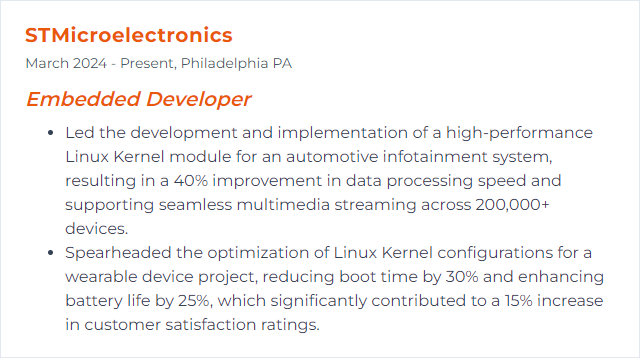
6. Microcontrollers
Microcontrollers are compact integrated circuits designed to execute specific operations within embedded systems, featuring a processor core, memory, and programmable input/output peripherals, enabling developers to create dedicated functions and control embedded devices efficiently.
Why It's Important
Microcontrollers are crucial for embedded developers as they serve as the brains of embedded systems, enabling precise control and processing in real-time applications, ranging from simple household devices to complex industrial machinery.
How to Improve Microcontrollers Skills
Improving microcontrollers as an embedded developer involves enhancing both the hardware capabilities and software efficiency. Here are concise strategies:
Optimize Power Consumption: Use low-power modes effectively. Implement sleep modes and power gating techniques to reduce energy usage during idle times. Texas Instruments Power Management
Upgrade Firmware Efficiently: Develop and maintain efficient code. Utilize compiler optimizations, and minimize resource-intensive operations. Microchip Code Optimization
Utilize RTOS Appropriately: Choose a Real-Time Operating System (RTOS) that matches your project requirements for better task management and timing accuracy. FreeRTOS
Implement Effective Debugging Tools: Use advanced debugging tools for timely identification and fixing of bugs. SEGGER J-Link Debug Probes
Incorporate External Modules: When necessary, integrate external modules for additional functionalities instead of changing the microcontroller. SparkFun Electronics
Enhance Communication Protocols: Optimize the use of communication protocols for faster and more reliable data transfer between devices. Controller Area Network (CAN) Protocol
Follow Best Coding Practices: Write readable, maintainable code and adhere to industry standards for software development. MISRA C Guidelines
Continuous Learning and Training: Stay updated with the latest technologies and practices in embedded systems. Embedded Systems Programming Course on Coursera
By focusing on these areas, an embedded developer can significantly improve the performance and functionality of microcontrollers in their projects.
How to Display Microcontrollers Skills on Your Resume
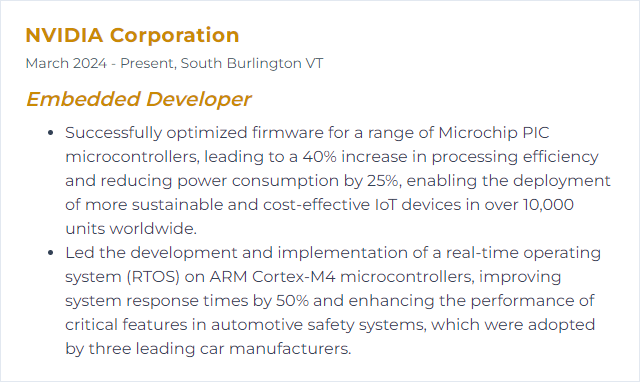
7. FPGA
An FPGA (Field-Programmable Gate Array) is a reconfigurable integrated circuit that an embedded developer can program to perform specific logic functions, enabling custom hardware acceleration for high-performance tasks.
Why It's Important
FPGAs (Field-Programmable Gate Arrays) are important for Embedded Developers because they offer customizable, high-performance hardware acceleration for specific tasks, allowing for real-time processing, rapid prototyping, and flexible system design.
How to Improve FPGA Skills
Improving FPGA (Field-Programmable Gate Array) performance and efficiency involves several strategies focused on design optimization, resource management, and power consumption. Here's a concise guide for an Embedded Developer:
Optimize HDL Code: Write efficient VHDL or Verilog code. Focus on synthesizable constructs and avoid unnecessary complexity. HDL Best Practices
Effective Clock Management: Use clock enabling and gating to reduce power consumption and improve speed. Clock management techniques are crucial. Clock Management Techniques
Resource Utilization: Efficiently use FPGA resources (LUTs, BRAMs, DSP slices) to balance speed and area. Proper resource management can significantly impact performance. Resource Utilization Guide
Pipeline and Parallelize: Implement pipelining and parallel processing to maximize data throughput and minimize latency. This takes advantage of FPGA's parallelism capabilities. Pipeline and Parallel Processing
Power Optimization: Optimize for power by reducing switching activity, managing static power, and employing FPGA-specific power reduction techniques. Power Optimization Techniques
Use of IP Cores: Leverage built-in Intellectual Property (IP) cores for common functions to save development time and optimize performance. IP Cores
Design Simulation and Testing: Use simulation tools extensively to validate your design's performance and functionality before deployment. Simulation Best Practices
Profiling and Optimization Tools: Utilize FPGA vendor-specific tools for profiling and optimization to fine-tune performance. Xilinx Profiling Tools
By applying these strategies, embedded developers can significantly improve FPGA performance, reduce power consumption, and make the most of their FPGA designs.
How to Display FPGA Skills on Your Resume

8. I2C/SPI
I2C (Inter-Integrated Circuit) and SPI (Serial Peripheral Interface) are both communication protocols used in embedded systems for interfacing microcontrollers with various peripherals such as sensors, memory devices, and other microcontrollers.
I2C is a two-wire, half-duplex communication protocol with support for multiple masters and slaves, using a serial data (SDA) and serial clock (SCL) line for communication. It is well-suited for short-distance, intra-board communication.
SPI is a four-wire, full-duplex communication protocol with a single master and multiple slaves, using separate lines for data input (MISO), data output (MOSI), clock (SCK), and slave select (SS). It offers higher data transfer speeds than I2C and is suitable for devices requiring fast communication.
Both protocols are widely used in embedded systems for their simplicity and effectiveness in managing communication between integrated circuits.
Why It's Important
I2C/SPI are crucial for embedded developers as they enable efficient communication between microcontrollers and various peripherals (like sensors and displays) using minimal wiring, saving space and reducing complexity in embedded systems designs.
How to Improve I2C/SPI Skills
Improving I2C/SPI communication in embedded systems involves optimizing speed, reliability, and power consumption while ensuring data integrity. Here are concise strategies for both protocols:
I2C Improvement Strategies
Increase Clock Speed: Within the limits of your devices and signal integrity, increasing the I2C clock speed can improve data throughput. Check device datasheets for max speeds. (I2C-bus specification)
Use Clock Stretching Sparingly: While it allows slave devices to slow down the master, it can introduce complexities and reduce overall speed. Minimize its use when possible. (Understanding the I2C Bus)
Proper Pull-up Resistor Selection: Choose pull-up resistors based on bus speed and capacitance to maintain signal integrity and reduce power consumption. (Choosing the Correct Pull-up Resistor)
SPI Improvement Strategies
Maximize Clock Speed: Similar to I2C, increasing the SPI clock rate improves throughput. Ensure all devices can handle the chosen speed without data corruption. (SPI - Serial Peripheral Interface)
Shorten Cables: Reduce cable length to minimize resistance, inductance, and capacitance, which can degrade signals and limit speed. (Best Practices for the PCB Layout of Oscillators)
Use DMA for Data Transfers: Direct Memory Access (DMA) offloads data transfer tasks from the CPU, increasing efficiency and freeing the CPU for other tasks. (Using DMA for Peripheral Data Transfer)
Optimize SPI Mode and Bit Order: Select the correct clock polarity and phase that matches your devices for reliable communication. Ensure the bit order (MSB or LSB first) is consistent across all devices. (SPI Protocol Basics)
General Tips
- Use Oscilloscopes/Logic Analyzers: Regularly analyze your signals to ensure integrity and diagnose issues like noise or incorrect timing.
- Software Debouncing: Implement software techniques to debounce signals, especially in noisy environments.
- Firmware Optimization: Optimize your firmware's handling of communication protocols to prevent bottlenecks and ensure efficient data processing.
Improving I2C/SPI communication is a balance between hardware configuration, software efficiency, and choosing the right settings for your specific application. Regular testing and optimization based on the device datasheets and standards will lead to the best performance.
How to Display I2C/SPI Skills on Your Resume

9. Bluetooth Low Energy (BLE)
Bluetooth Low Energy (BLE) is a power-conserving variant of classic Bluetooth technology, designed for short-range communication and low-power applications, enabling wireless connectivity between devices like sensors, smartwatches, and smartphones with minimal energy consumption. It's especially relevant for embedded developers looking to implement efficient wireless communication in battery-powered devices.
Why It's Important
For an Embedded Developer, Bluetooth Low Energy (BLE) is crucial because it enables the development of power-efficient, wireless communication solutions that are essential for the proliferation of battery-powered smart devices and IoT applications.
How to Improve Bluetooth Low Energy (BLE) Skills
Improving Bluetooth Low Energy (BLE) performance in embedded systems involves optimizing power consumption, data throughput, and connection reliability. Here's a concise guide for embedded developers:
Power Optimization: Use BLE's power-saving modes like sleep and deep sleep effectively. Implement efficient power management strategies in your firmware to extend battery life. Texas Instruments offers a comprehensive guide on low-power design.
Data Throughput: Optimize data packet size and interval timing for your application's needs. Choosing the optimal data length and transmission interval can significantly improve throughput. Nordic Semiconductor provides insights on maximizing data throughput.
Connection Reliability: Ensure robust connection parameters and implement effective error handling and retransmission strategies. Utilize adaptive frequency hopping to mitigate interference issues. Bluetooth SIG’s Best Practices guide is a valuable resource.
Security Enhancements: Implement the latest BLE security features to protect against eavesdropping and ensure data integrity. Understanding BLE security mechanisms is crucial, as outlined by Bluetooth SIG.
Software and Firmware Updates: Keep your BLE stack and firmware updated to leverage improvements and bug fixes. Utilize over-the-air (OTA) updates for efficient deployment.
Use of BLE 5 Features: If your hardware supports it, take advantage of BLE 5 enhancements like increased range, speed, and broadcast capacity. Silicon Labs provides a technical overview of BLE 5 features.
Profiling and Debugging Tools: Employ profiling tools to analyze power consumption and performance bottlenecks. Nordic Semiconductor’s Power Profiler Kit is an example of a tool for optimizing power consumption.
Community and Support Forums: Engage with developer communities and forums for support and sharing best practices. The Stack Overflow BLE tag and Bluetooth SIG’s Developer Forum are good places to start.
By focusing on these areas, embedded developers can significantly improve the performance and efficiency of BLE in their projects.
How to Display Bluetooth Low Energy (BLE) Skills on Your Resume
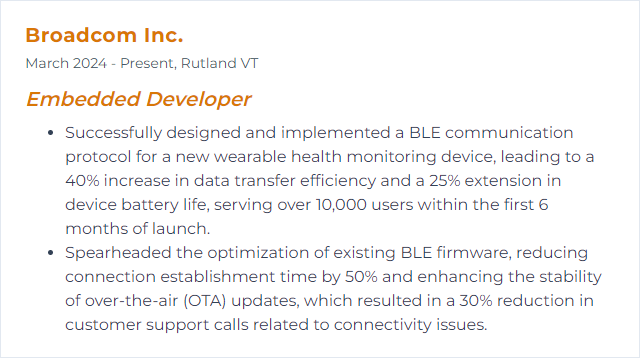
10. Embedded Linux
Embedded Linux refers to a tailored version of the Linux operating system designed to run on embedded devices and systems. It provides developers with a scalable, flexible, and secure OS foundation for building various applications and functionalities into hardware ranging from consumer electronics to industrial equipment.
Why It's Important
Embedded Linux is important for an Embedded Developer because it provides a versatile, open-source OS platform that supports a wide range of hardware, offers robust networking capabilities, and facilitates customization and scalability, enabling efficient development of reliable and high-performance embedded applications.
How to Improve Embedded Linux Skills
Improving Embedded Linux systems involves enhancing performance, reducing footprint, and ensuring system robustness. Here are concise strategies for an Embedded Developer:
System Optimization: Focus on kernel and application optimization. Customize the Linux kernel to your hardware by removing unnecessary drivers and features. Use tools like
make menuconfigfor kernel customization. Kernel ConfigurationBoot Time Reduction: Analyze and minimize the boot process. Tools like
systemd-analyzecan help identify bottlenecks. Consider using Buildroot or Yocto Project for a more tailored system. Boot Time OptimizationMemory Management: Optimize memory usage through efficient coding practices and by using memory profilers like Valgrind. Employ techniques such as using
mmap()for large memory allocations. Memory Management TipsFilesystem Selection and Optimization: Choose the right filesystem for your needs (e.g., SquashFS for read-only systems). Optimize filesystem performance and reliability based on your application's read/write patterns. Filesystem Comparison
Security Hardening: Implement security best practices, including using secure boot, encrypting data at rest and in transit, and regularly updating software components. Tools like IMA/EVM can help in ensuring integrity. Linux Security Hardening
Power Management: Implement effective power management techniques and use tools like PowerTOP to analyze power consumption. Employ strategies like Dynamic Voltage and Frequency Scaling (DVFS) for energy efficiency. Power Management for Embedded Linux
Real-Time Performance: For applications requiring real-time performance, consider using a real-time patch (PREEMPT_RT) or selecting a real-time Linux kernel. Real-time scheduling policies (e.g., SCHED_FIFO) can also be crucial. Real-Time Linux
Continuous Integration/Continuous Deployment (CI/CD): Implement CI/CD pipelines using tools like Jenkins or GitLab CI for automated building, testing, and deployment, ensuring code quality and system reliability. CI/CD for Embedded
Documentation and Community Engagement: Keep up-to-date with the latest developments and engage with the Linux embedded community for support and sharing insights. Linux Embedded Community
By focusing on these key areas, embedded developers can significantly improve the performance, security, and reliability of their Embedded Linux systems.
How to Display Embedded Linux Skills on Your Resume
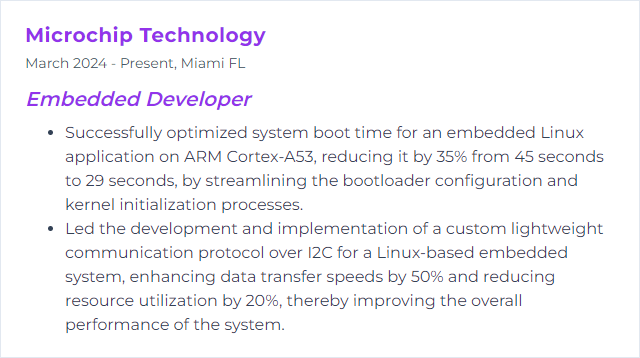
11. Git
Git is a distributed version control system used for tracking changes in source code during software development, enabling multiple developers to collaborate efficiently on a project, including those working on embedded systems.
Why It's Important
Git is crucial for an embedded developer as it provides version control for code, enabling efficient management of firmware versions, collaboration with team members, and tracking of changes across the development lifecycle, ensuring software reliability and easier debugging.
How to Improve Git Skills
Improving your Git skills as an Embedded Developer involves mastering techniques that streamline your version control process, enhance code safety, and facilitate collaboration. Here are concise suggestions with relevant resources:
Master Git Basics: Ensure you're comfortable with fundamental Git operations. Pro Git book is an excellent resource.
Use Branching Strategies: Implement a branching strategy like Git Flow to manage features, releases, and fixes efficiently. Atlassian’s guide on Git branching strategies is a great starting point.
Leverage Git Hooks: Automate your workflow with Git hooks. For example, pre-commit hooks can run automated tests or code formatting checks. Git Hooks documentation provides detailed insights.
Embrace Continuous Integration (CI): Integrate your Git repositories with CI tools like Jenkins or GitHub Actions to automate testing and building processes. GitHub Actions for CI/CD offers a straightforward way to get started.
Optimize Large File Handling: Use Git LFS (Large File Storage) for managing large binary files efficiently, crucial in embedded development for handling firmware images or libraries. Git LFS tutorial covers its implementation.
Version Control for Hardware Design: Explore version control systems designed for hardware projects, like Sigasi for VHDL/Verilog or KiCad for PCB design, integrating these tools with Git. Version Control in KiCad demonstrates integrating hardware design with Git.
Regularly Review and Refactor Your Repositories: Keep your repositories clean by periodically reviewing and refactoring your code and Git history. This includes pruning obsolete branches and squashing trivial commits. Rewriting History section of Pro Git provides guidelines.
Stay Updated: Git and related tools evolve, offering new features and improvements. Follow the official Git blog for updates and announcements.
By focusing on these areas, you can significantly improve your Git proficiency, making your embedded development workflow more efficient and robust.
How to Display Git Skills on Your Resume

12. IoT Protocols
IoT protocols are standardized rules and methods that enable communication between various devices and systems within the Internet of Things (IoT) network. For an embedded developer, these protocols are crucial for ensuring interoperability, security, and efficient data exchange between embedded devices and the broader IoT ecosystem. Examples include MQTT for lightweight messaging, CoAP for web-based interaction, and Zigbee for local network communication.
Why It's Important
IoT protocols are crucial for embedded developers as they enable efficient, secure, and interoperable communication between devices and platforms in the Internet of Things ecosystem, ensuring optimal performance and scalability of IoT applications.
How to Improve IoT Protocols Skills
Improving IoT protocols involves enhancing security, efficiency, interoperability, and scalability. As an embedded developer, focus on these key areas:
Security: Prioritize implementing robust encryption methods and secure authentication mechanisms to protect data transmission. Explore TLS/DTLS for securing communications.
Efficiency: Optimize protocol stack size and data payload to reduce memory footprint and bandwidth usage. Lightweight protocols like MQTT-SN are designed for such efficiency.
Interoperability: Ensure your IoT devices can communicate across different platforms and protocols by adhering to widely accepted standards like CoAP and LwM2M.
Scalability: Design your system to handle an increasing number of devices seamlessly. Techniques include using message brokers for MQTT or adopting IPv6 for a larger address space.
For in-depth exploration, consider resources like the IoT Developer's Guide for practical insights and Embedded Artistry for technical articles and best practices.
How to Display IoT Protocols Skills on Your Resume
